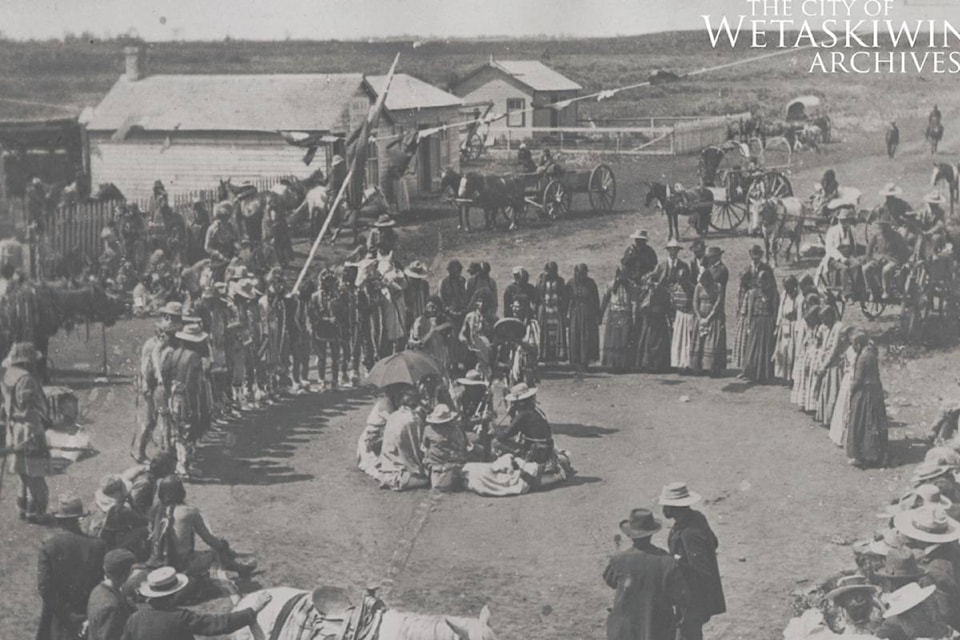Did you take the opportunity to go to the Samson Pow Wow recently, or the Ermineskin one in July?
I vividly remember my first pow wow. I had seen Indigenous dancing before, but these were performances for an event, the Calgary Stampede, the opening ceremonies for the ’88 Olympics, etc. The pow wow, however, was different. Maybe this was simply because there was more of everything and I had a sensory overload. I think though that it was different because I wasn’t witnessing culture, but instead experiencing it. This wasn’t a showcase put on for my benefit to entertain. While there is nothing wrong with this kind of cultural exchange, and I still enjoy every performance I see, it is just not the same as going to a pow wow and truly experiencing it as a celebration for the entire community. Pow wows are also more than just dancing, drumming and singing. They are a family friendly festival, a reunion, a food fair, and an arts and craft market. They can also include a variety of other activities such as traditional hand games, rodeos, golf tournaments, runs and parades.
The earliest photographic evidence I have seen of such a celebration in our community is in one of my favourite items in the City of Wetaskiwin Archives’ collection. Dated to 1897, it depicts a small group on “Main Street” Wetaskiwin. This is only five years after Wetaskiwin’s founding in 1892. If you look closely the group in the centre of the photo are sharing a pipe. They are accompanied by three hand drummers and encircled by what are presumably Cree people with the men on one side and the women on the other. What appears to be the Canadian Red Ensign (the de facto flag of Canada prior to 1965) is being flown above their head.
The presence of the Red Ensign is significant. This photo was taken well within the time-line of restrictions put forth in the Indian Act of 1876, which for 75 years outlawed all Indigenous cultural and spiritual ceremonies unless sanctioned by the Canadian government for entertainment. We can assume that the ceremony we are seeing in the picture was one of these sanctioned events and for the benefit of the settlers surrounding the circle. Despite these restrictions, ceremonies and celebrations continued here in our community of Wetaskiwin City, County, and Maskwacis and across North America, though often in secret.
What we think of today as a pow wow really had its resurgence after WW2 when returning Indigenous veterans demanded freedom of religion and the right to practice their traditional ceremonies. This led to the restrictions being lifted in an amendment to the Indian Act in 1951, but after decades of suppression it has taken years to re-teach and strengthen traditional culture and language. This is on going and often a theme of pow wows.
I have heard many stories about going to Sundances and pow wows from people of all ages, for most they are remembered as fond memories of their childhood. These stories and the spectacular celebration we see twice a year at Bear Park are a testament to the resilience of our friends, neighbours, and colleagues. The knowledge of this resilience gives me strength, and this weekend it created a moment of pride in what the people of our community have accomplished for the benefit of our future generations.
The museum entered a float in both the Ermineskin and Samson pow wow parades. Our theme was “Sharing our History” and the float included museum board, staff, and youth network members who were joined by some very talented young dancers and surrounded by symbols of our community: milk cans, a model horse, and replicas of the water tower and peace cairn. There was a moment during the parade where it hit me how incredibly lucky we were. Our combined heritage included Cree, German, English, French Canadian, Vietnamese, and Japanese, and we were all together on that trailer bed smiling, laughing, and of course dancing, all because of the pow wow.
We truly are privileged to live in a community that has at least two great pow wows every year (there are also smaller celebrations throughout the year). If you’ve been to a pow wow you’ll understand why these celebrations are one of the highlights of my summer and epitomize what I love about our community and its rich and diverse heritage. If you haven’t, don’t worry, because if the organizers are anything like me, they are already thinking about next year’s celebrations!
Dr. Karen Aberle is the Executive Director & Chief Curator at the Wetaskiwin & District Heritage Museum and writes a regular column for the Pipestone Flyer. She can be reached at wdhm@persona.ca.
